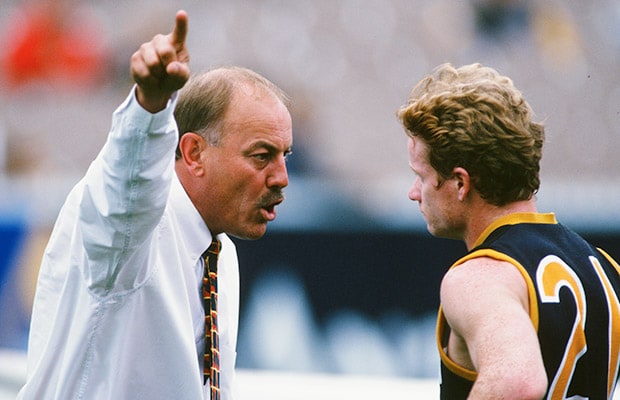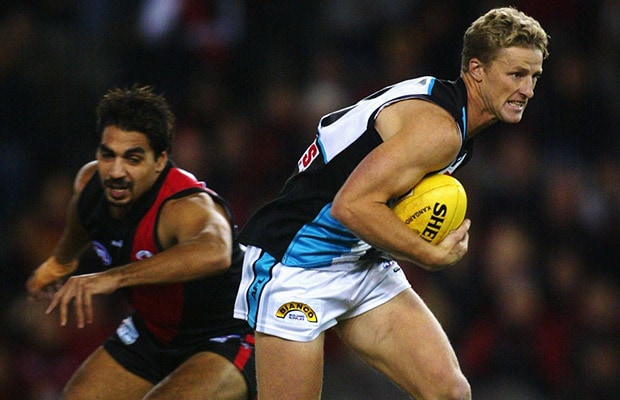• Keep track of the latest retirements, delistings and trades
• Indicative draft order: What picks will your club take to the draft?
• Ten things we learned from the Trade Period
• Sliding Doors: Trade Period wash-up
RUTHLESS Hawthorn overcame numerous obstacles during their premiership dynasty of 2013-15, and the Hawks will have to break new ground again if they are to salute next year.
Hawthorn's decision to part with star veterans Sam Mitchell and Jordan Lewis will be debated long after their traded-in successors Jaeger O'Meara and Tom Mitchell hang up their boots.
And just to add further fuel to the inferno we thought it timely to reflect upon several other occasions when multiple key players left clubs.
The circumstances varied but, in a finding that will heighten anxiety among Hawks fans, in recent times there weren't many success stories to emerge from such drastic measures.
And Hawthorn's case is unique – in each of the other instances we've identified, none of those clubs lost the top two place-getters in their best and fairest award.
To take the glass-half-full approach to the Hawthorn situation, let's start with an instance in which the effected club enjoyed immediate success after undergoing dramatic change.
Blight's Crow cull
As a coach, Malcolm Blight was never afraid to make a statement or tread on a few toes, and that's exactly what he did when he was appointed coach of Adelaide at the end of 1996.
Blight, who'd lost three Grand Finals at Geelong between 1989-94, caused something of a sensation when he sacked Crows veterans in captain Tony McGuinness, ex-skipper Chris McDermott, Andrew Jarman and Greg Anderson.
This decorated midfield quartet had represented South Australia on numerous occasions and received All Australian selection, and McDermott was the only one among them not to have won the SANFL's Magarey Medal.
In some ways, their axing was similar to North Melbourne's decision this year to part with stalwarts Brent Harvey, Drew Petrie, Nick Dal Santo and Michael Firrito.
Blight copped enormous flak at the time, just as the Kangaroos have, but his list-management decisions soon proved masterstrokes as he lifted the Crows to the next two premierships with youthful, hard-running teams that repeatedly ran over the opposition.
Now look away, Hawks fans, because we're about to highlight some cautionary tales.
Malcolm Blight was no stranger to tough list management decisions. Picture: AFL Photos
Self-destructive Tigers
Hawthorn's preoccupation with landing O'Meara has prompted some to question whether the former Sun will become 'the new John Pitura'.
Pitura was a South Melbourne star when dual reigning premier Richmond snared him in 1975 in exchange for three players: eventual Brownlow medallist Graham Teasdale, the recently deceased Brian 'Whale' Roberts and Francis Jackson.
In an infamous trade deal, this trio flourished at South while Pitura failed to live up to expectations in just three seasons as a Tiger.
But in terms of Tiger obsession, worse was to come.
Richmond won the 1980 premiership and was runner-up in 1982, but hasn't made a Grand Final since.
According to many, the catalyst for the Tigers' decline was the loss of disenchanted stars David Cloke and Geoff Raines to Collingwood for 1983, sparking a bitter poaching war that sent both clubs to the brink of destruction.
The Dons' duo of debacles
The Bombers made controversial list-management decisions after both their 1985 premiership and 2001 Grand Final appearance, and in each case team chemistry was effected, contributing to gradual slides down the ladder.
In 1986, the dual reigning premier suffered serious injuries to midfield stars Tim Watson and Darren Williams, so the Bombers jumped at the chance to grab Collingwood duo Raines and Mike Richardson, who'd both walked out of Victoria Park after refusing to take pay cuts.
To squeeze them in, the Dons paid a considerable price, offloading Peter Bradbury to the Magpies and Steve Carey to Geelong. Both had been popular, respected team members.
To complete the messy predicament, Raines and Richardson spent just one season at Windy Hill before joining the new Brisbane Bears franchise.
Essendon made the finals in that 1986 season but wouldn't reach September again until 1989.
And when coach Kevin Sheedy assembled another super team, winning the 2000 flag and falling just short the following year, the club was eventually forced to release salary-cap pressure.
The Bombers traded defender Damien Hardwick to Port Adelaide (where he won another premiership) and came within a whisker of sending centreman Joe Misiti to Collingwood.
The next year, 2002, Blake Caracella became a Lion and Justin Blumfield a Tiger while Chris Heffernan and Gary Moorcroft became Demons.
Once again, the culture that had been so carefully created and nurtured came under serious threat, and over four years Essendon dropped from second to 13th, and then a club-low 15th.
Salary cap pressures forced Damien Hardwick out of Essendon to Port Adelaide. Picture: AFL Photos


